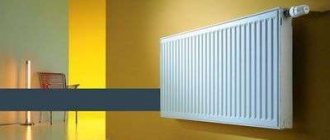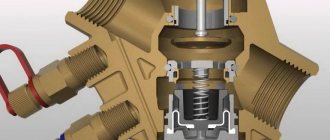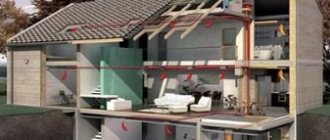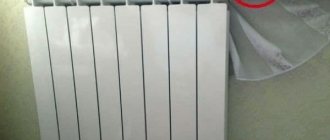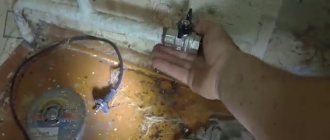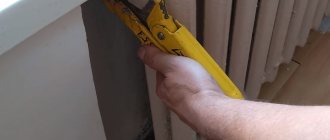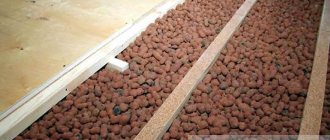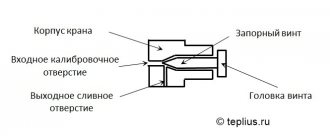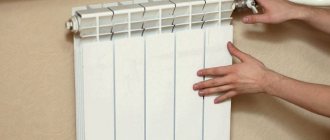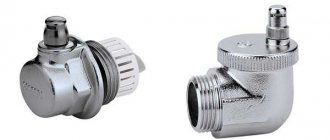The answer to the question of how to turn off the heating battery is extremely simple - just close one tap, leaving the second open. But which tap should you turn off? As we understand, water is supplied to the heating riser from below. The top tap is closed and the bottom tap is open. The top tap is closed and the bottom tap is open. If repair work is carried out at the neighbors below or in the basement, or on the branch that supplies the house, the coolant will be drained and your radiator will be empty. If it is steel or cast iron, it will cause corrosion. The bottom tap is closed and the top tap is open.
Why battery-powered faucets?
Taps allow you to screw on or completely disconnect a certain part of the radiators. Equally important for saving money is periodic flushing of heating appliances.
Interesting materials:
How many unconfirmed Bitcoin transactions are there? How many independent states are there in the British Isles? How many legs does a chicken have? How many legs do spiders and ants have? How many standards were required to be met for BGTO? How many points do you need for a teacher? How much bobbin yarn do you need? How long should you keep a floral sponge in water? How much liquid smoke should I add? How many photos do you need for an ID?
How to adjust the temperature in the apartment
- If the apartment is often hot to such an extent that there is a desire to turn off the radiators, consider installing temperature regulators on the radiators. If the battery has a bypass, you can install a thermostat at the entrance to the battery, which will regulate the temperature in the room.
- If there is no bypass, it is prohibited to install control devices, since if such devices are present, you will set the temperature not only in your apartment, but also for all your neighbors in the riser. In this case, you can replace the heating battery and install a bypass.
To shut off the heating device, ball valves are required.
For those who live in houses with central heating, questions about how to turn off the radiator usually arise in two cases:
- if the weather is warm outside and the central heating has not yet been turned off, since the heating season has not officially ended;
- if necessary, replace, repair or paint the radiator, repair the wall behind the radiator.
In this case, one should take into account this point: there is always a coolant inside the battery. It is drained only in case of repair work in the system
This is due to the fact that the main part of the heating devices installed in old houses, as well as the intra-house wiring, are made of steel.
The liquid inside the heating battery contains a certain amount of oxygen in dissolved form, which over time completely reacts with the metal, as a result of which corrosion stops.
You cannot leave the system or a separate heating device unfilled for a long time - moisture remains on the inner surface of the steel or cast iron battery, which does not evaporate for a long time in a confined space. This significantly accelerates the corrosion process. Thus, the coolant is drained only in exceptional cases.
Why is the water not drained at the end of the heating season?
As you know, water remains in heating networks even in summer. This is explained by the fact that in this way corrosion processes inside radiators and pipelines are reduced. And it is water that will help prevent corrosion, since in this case steel and cast iron will be much less susceptible to rust. No matter how paradoxical it may sound, it really is so. For what reasons does this happen? Everything is quite simple: (See also: How to disassemble a cast iron heating radiator with your own hands)
- Water is constantly inside the heating system and does not allow metal to come into contact with air. Corrosion occurs when a metal comes into contact with dissolved oxygen in water;
- Due to the isolation of the heating system from the outside world, the water is quickly deprived of dissolved oxygen. Then the oxidation process, which is usually a catalyst for corrosion processes, is completely eliminated.
- As a result of all this, the heating network does not rust at all from the inside, which cannot be said about the cold and hot water pipeline system. However, if water is removed from the system, moist air with a high oxygen content will remain. This is precisely why pipes and radiators rust from the inside in the absence of coolant. (See also: How to calculate bimetallic heating radiators)
Before turning off the radiator, you need to study the other side. According to established standards, the heating network must always contain water. At the same time, some management organizations often neglect this requirement in order to save money. Thus, during repairs, it is necessary to drain water from the system, and then refill the network with it, wasting time. If batteries are replaced and repaired in several apartments over the course of one summer, the management company will have to drain and refill the system each time. Therefore, in some cases, pipes are left without water at all during the summer. Due to the closed system, the pipes will not be able to dry from the inside, and moisture will trigger corrosion processes.
Why is the water not drained at the end of the heating season?
As you know, water remains in heating networks even in summer. This is explained by the fact that in this way corrosion processes inside radiators and pipelines are reduced. And it is water that will help prevent corrosion, since in this case steel and cast iron will be much less susceptible to rust. No matter how paradoxical it may sound, it really is so. For what reasons does this happen? Everything is quite simple: (See also: How to disassemble a cast iron heating radiator with your own hands)
- Water is constantly inside the heating system and does not allow metal to come into contact with air. Corrosion occurs when a metal comes into contact with dissolved oxygen in water;
- Due to the isolation of the heating system from the outside world, the water is quickly deprived of dissolved oxygen. Then the oxidation process, which is usually a catalyst for corrosion processes, is completely eliminated.
- As a result of all this, the heating network does not rust at all from the inside, which cannot be said about the cold and hot water pipeline system. However, if water is removed from the system, moist air with a high oxygen content will remain. This is precisely why pipes and radiators rust from the inside in the absence of coolant. (See also: How to calculate bimetallic heating radiators)
Before turning off the radiator, you need to study the other side. According to established standards, the heating network must always contain water. At the same time, some management organizations often neglect this requirement in order to save money. Thus, during repairs, it is necessary to drain water from the system, and then refill the network with it, wasting time. If batteries are replaced and repaired in several apartments over the course of one summer, the management company will have to drain and refill the system each time. Therefore, in some cases, pipes are left without water at all during the summer. Due to the closed system, the pipes will not be able to dry from the inside, and moisture will trigger corrosion processes.
Very important information
Below we will describe situations when one or another inclusion of the battery may be undesirable, and sometimes unacceptable!
By reading my blog, you are probably making repairs.
this page to your bookmarks . This is where all the useful home improvement stores are located.
| Not every plumbing store sells heating regulators. Here is a fairly powerful catalog with a large selection of thermostats, which can be filtered by price and manufacturer. |
4.1.You cannot use the thermostat without a jumper
In point 2 we talked about the thermostat. However, you need to understand that experiments with a temperature controller are only possible with a jumper! If it is not there, and you reduce the diameter of the flow pipe, then the total flow of hot water through your apartment will decrease. Which of course is unacceptable, otherwise your neighbors will come to you!
4.2. The thermostat may become clogged
If you are using a jumper, but for some reason it was turned off for a while and the thermostat was set to position 5, i.e. provided a full flow of hot water only through the battery, as shown in the figure:
then everything seems to be fine. However, we must accept reality as it is. Even if we turned on the central heating radiators correctly for the first time, there is no guarantee that, for example, in a month or two a new mud flow will not pass through the pipes. But then, if the jumper is turned off, then the splash of dirt will go straight to your thermostat, which, in fact, is very sensitive to it. As a result, a blockage forms in the thermostat, and water will not flow into the battery at all. It won’t go into the jumper either, because you closed it. Therefore, in this situation, water will stop flowing through your apartment; in the house, through your heating riser, the water will also stop and begin to cool in the cold. As a result, a squad of evil neighbors, together with the chairman of the HOA or housing cooperative, is guaranteed to enter your apartment.
It is clear that switching on according to the above figure is similarly not acceptable for the regulator positions 4,3,2,1,*
4.3. The jumper must always be on
Make it a rule that it doesn’t matter whether you use a temperature controller or not, but the jumper should always be on. This way, you will always ensure hot water flow through your apartment. When does it make sense to turn off the jumper? For example, when you feel that the battery is clogged. Then you let all the water flow through the battery by disconnecting the jumper. Perhaps a more powerful stream of hot water will be able to push through the stuck dirt. But this needs to be done for a short time and only under your control - you cannot leave the situation like this and go to sleep. The fact is that if the dirt cannot be pushed through, then a congestion will form again: water will not be able to pass through either the battery or the jumper.
4.4. During installation, the thermostat must be installed behind the jumper, i.e. directly in front of the battery
This is mega important, because if it is installed before the jumper, then when you first turn it on, dirt will definitely clog your thermostat, and you will start the heating season with a complete rewiring of the battery:
4.5. Avoid outright carelessness when installing ball valves in different positions
This installation of ball valves in your system will again ensure that your neighbors come to you:
You just completely turned off the water :).
Well, that's all, dear readers! I tried to tell you in as much detail as possible about the nuances of operating heating batteries!
Have you ever accidentally blocked the heating pipe in your house?
Is it possible to leave the heating system without water in the summer?
Do not completely block the flow of water to the radiator. Turning off the radiator is possible only during the period of pressure testing (a set of works to identify faults) of the heating system.
Do not leave a heating system with aluminum radiators without water for more than 15 days a year.
In what position should the supply valves be located?
With regard to supply taps, it would be correct to do this: close the bottom tap, open the top tap. With this position of the taps, the presence of water in the battery throughout the entire period: spring - summer - autumn - winter will be ensured, there will be no threat of vacuum formation and everything will be fine with the battery.
What will happen if you don’t turn off the taps?
When the hot water supply starts and stops, all the rust flows through the pipes. If the taps are not turned off, very dirty water will pass through the battery and the battery may become clogged. However, if for some reason both supply taps must remain in the “closed” position, be sure to open (unscrew) the Mayevsky tap. Otherwise, the radiator may rupture due to a chemical reaction between the additives contained in the coolant and aluminum. Please note that if the radiator ruptures, this will not be a warranty case!
What if you turn off both taps?
As the water begins to cool, its volume in the battery will begin to decrease. This will cause a vacuum to form there. Why is he so scary? Your battery will experience severe pressure once a vacuum begins to form inside it. It will either become deformed or crack. To avoid this, after the end of the heating season, you should never turn off both taps!
What to do when a new heating season approaches?
After you have learned that the heating will be turned on the next day, remember that at the moment the water is supplied, the rustiest water will flow through the pipes. To avoid clogging the battery, turn off both taps! The jumper (bypass) must be open at this time!
When hot water is supplied, it will flow through the bypass. We advise you not to turn on the battery for the first couple of days. Let all the rust pass by your radiators!
From the bypass, the water in the battery will begin to heat up slightly, which will lead to an increase in pressure inside the battery, but this should not scare you. A slight increase in pressure cannot lead to deformation of the radiator.
1-2 days after supplying hot water through the jumper, open both taps on the battery.
That's it, you and your heating system are ready for winter!
After installing brand new heating radiators for a considerable amount of money, many people want to extend their service life and not lose heat transfer, or prevent them from becoming clogged with dirt. New radiators, unlike old cast-iron radiators, have shut-off valves that can be closed. The question immediately arises: should we block it or not?
To answer this question, it is advisable to find out whether your housing office is bona fide or not. Namely, whether it keeps the system filled with water when the heating is turned off or not.
The fact is that the main enemy of metal is corrosion. It manifests itself to a lesser extent when the system is dry or when it is completely filled with water, without air access. The fertile environment for destruction is moisture and oxygen. According to standards, the system should always be filled with water, but many management companies ignore this. Firstly, during repairs, the system has to be drained and then refilled, wasting time. Secondly, water is now metering devices and real money. If over the summer 10 people in a house decide to change or repair the batteries, the system will have to be drained and filled 10 times, and it’s good if you can drain individual risers and not the whole house at once, as, for example, I have. This is where some companies sin by not filling the tubes with water at all in the summer. Naturally, a closed system cannot dry out and moisture remains there. As already mentioned, air and moisture are excellent catalysts for corrosion.
Therefore, if your management company is not conscientious, it is better to close the cut-off valves on the eve of the end of the heating season. This can be done if, with the radiators closed, the coolant can flow bypassing them (along the riser or through a jumper). More on this below. Additionally, open the air bleed valve - to get rid of excess pressure that arises from a temperature difference or during a chemical reaction of the metal with the coolant, if the quality of this very metal and (or) coolant is not very good. The main thing is this tap, correctly it is called the Mayevsky tap, then don’t forget to close it.
You can check whether a company is bona fide or not several times during the summer. To do this, open the top valve and the air bleed valve. If water or first air then water presses through the faucet, there is water in the system. At the same time, the bottom valve, which remains closed, will not allow water to escape from your radiator if the system is not full.
The question logically arises: why check anything at all? It's better to block everything. It turns out not always.
Radiator with jumper
If you have a jumper next to the radiator, you can close the shut-off valves and not have to monitor whether there is water in the system or not.
Radiator without jumper and riser
If all the coolant flows through the battery and there is no jumper, the batteries should never be shut off.
Radiator without jumper with riser
If the riser goes through your apartment, and there are no jumpers near the radiators, then with the shut-off valves closed and a conscientious company filling the system with water for the summer, air pockets may form in your pipes, from the riser to the battery. The same air and moisture. Therefore, if the management company is in the habit of keeping the system filled with water, the shut-off valves can be kept open. This can help avoid air pockets when filling.
As for closing radiators or not while flushing the heating system, if the radiators are new and have been used for the first 1-2 years, close them. It will drag in more dirt than it will wash off. Ideally, they should be opened a day after turning on the heating in the house, after the main dirt has gone away. Once every 1-2 years, it is advisable to remove the radiators and wash them yourself with hot water. Close attention to each radiator is clearly better than a general system flush. Fortunately, these are not cast iron batteries. They are removable perfectly, and you can wash them with a shower hose, twisting the watering can off it and removing the gasket so that it does not get inside.
Before removing, do not forget to close the shutoffs and lay a rag on the floor, or better yet, a thick film and a rag on top. Radiators may leak a natural black slurry that will be difficult to clean off the floor. They should also be placed in the bathroom. To protect against damage and heavy dirt. In general, the question of whether or not to shut off batteries should be guided by logic: - Heating radiators (batteries) must be constantly filled with water. — There is no need to expose them to excess pressure, which can occur if they are closed tightly. This means you need to leave the upper shut-off valve open while the lower one is closed, or close both shut-off valves and open the Mayevsky valve. Provided that your blocked battery does not disrupt the circulation throughout the riser. This is written above.
The question of whether or not to cover bimetallic radiators in the summer is similar to the question of whether or not to cover aluminum ones in the summer. The above is true for both types. The difference between them is that bimetallic radiators can withstand greater pressure and are less likely to release gas when the metal interacts with the coolant. Despite this, the rules must be followed for them as well.
Good afternoon, dear readers! Today I will continue the topic of central heating batteries. We will talk to you about the operation of heating batteries. Almost everyone needs this topic, and my task is to help you understand this issue once and for all. So, I hope you have already read my article: Correct installation of a central heating battery in an apartment. We will assume that the battery has been installed for you. What's next?
Different methods of dismantling
Methods for dismantling heating radiators primarily depend on what kind of fasteners are used and how they are located relative to the radiator.
The options may be the following:
- fitting connection;
- with the help of drives.
Fittings and connections are also different.
Typically, batteries made of Soviet-style cast iron were fastened with a bunch of clamps and locknuts. Modern radiators are mounted using American ones. The American is a collapsible fitting with a union nut.
The connections relative to the battery may be positioned differently. The connection can be one-way or two-way
Why is this so important to find out before unscrewing the radiator? If the installation is carried out using pipes, then one of the passage plugs on the radiator will have a left-hand thread.
Sometimes in high-rise buildings built at the end of the last century there are convectors that are connected to the supply pipes by a weld.
Recommendations from experts
Experts in the field of heating engineering advise:
- screw valves for adjustment are not suitable for shut-off valves, since after a short time the valve will certainly come off or be destroyed;
- it is necessary to purchase coupling ball valves for heating radiators;
- to adjust the flow of the heating battery, a fully open bypass jumper is required;
- On the second supply line, it is advisable to install another valve, which in the closed position completely cuts off the heating device, after which the radiator can be removed for repair.
Taps for heating radiators on video:
Very important information
Below we will describe situations when one or another inclusion of the battery may be undesirable, and sometimes unacceptable!
By reading my blog, you are probably making repairs.
this page to your bookmarks . This is where all the useful home improvement stores are located.
| Not every plumbing store sells heating regulators. Here is a fairly powerful catalog with a large selection of thermostats, which can be filtered by price and manufacturer. |
4.1.You cannot use the thermostat without a jumper
In point 2 we talked about the thermostat. However, you need to understand that experiments with a temperature controller are only possible with a jumper! If it is not there, and you reduce the diameter of the flow pipe, then the total flow of hot water through your apartment will decrease. Which of course is unacceptable, otherwise your neighbors will come to you!
4.2. The thermostat may become clogged
If you are using a jumper, but for some reason it was turned off for a while and the thermostat was set to position 5, i.e. provided a full flow of hot water only through the battery, as shown in the figure:
then everything seems to be fine. However, we must accept reality as it is. Even if we turned on the central heating radiators correctly for the first time, there is no guarantee that, for example, in a month or two a new mud flow will not pass through the pipes. But then, if the jumper is turned off, then the splash of dirt will go straight to your thermostat, which, in fact, is very sensitive to it. As a result, a blockage forms in the thermostat, and water will not flow into the battery at all. It won’t go into the jumper either, because you closed it. Therefore, in this situation, water will stop flowing through your apartment; in the house, through your heating riser, the water will also stop and begin to cool in the cold. As a result, a squad of evil neighbors, together with the chairman of the HOA or housing cooperative, is guaranteed to enter your apartment.
It is clear that switching on according to the above figure is similarly not acceptable for the regulator positions 4,3,2,1,*
4.3. The jumper must always be on
Make it a rule that it doesn’t matter whether you use a temperature controller or not, but the jumper should always be on. This way, you will always ensure hot water flow through your apartment. When does it make sense to turn off the jumper? For example, when you feel that the battery is clogged. Then you let all the water flow through the battery by disconnecting the jumper. Perhaps a more powerful stream of hot water will be able to push through the stuck dirt. But this needs to be done for a short time and only under your control - you cannot leave the situation like this and go to sleep. The fact is that if the dirt cannot be pushed through, then a congestion will form again: water will not be able to pass through either the battery or the jumper.
4.4. During installation, the thermostat must be installed behind the jumper, i.e. directly in front of the battery
This is mega important, because if it is installed before the jumper, then when you first turn it on, dirt will definitely clog your thermostat, and you will start the heating season with a complete rewiring of the battery:
Valve or shut-off valve
The valve can be called the brother of the gate valve. The device is activated by turning the flywheel, which transmits an impulse to the spindle, which begins to move forward and at the other end the spool, equipped with a gasket, closes. If the valve closes, then reaching the lower position, it rests against the seat, as a result of which the liquid is blocked (locked). This is where the name comes from - shut-off valve. Shut-off valves are widely used in water and fuel systems. They are shut-off and regulating and are presented in a wide variety of appearance and design. The service life varies from 20 to 30 years due to the quality of materials and operating characteristics. Wear occurs when 8 thousand closed-open cycles have been completed.
The devices also have their advantages and disadvantages. The advantages are determined by its operational characteristics:
- smooth regulation of water flow
- maintainability (replacement of the spool gasket or stuffing box gasket with its tightening);
- the presence of a smaller number of rubbing parts, which provides the valve with an increase in service life;
- the use of valves when regulating the flow of water to several objects (you simply cannot do without them) water and heat supply.
Disadvantages are characterized by a decrease in performance properties due to:
- increased hydraulic resistance, creating a stagnation zone where suspended particles can accumulate, which can cause premature wear and corrosion;
- failure of the spool gasket (separation by liquid flow, sticking, drying out), which leads to frequent repairs;
- the need to maintain the valve device in working condition, for which it should be completely opened or closed at least once a year if there has been no load in operation for a long time.
The exception to the rule here is a direct-flow valve with an inclined spindle, where less resistance is created in the hydraulics. This is achieved by the oriented position of the seat towards the fluid flow.
We solve problems with the heating network
Problems with technical communications occur very often, but for heating repair work it is not at all necessary to always remove the coolant from the pipes. The most popular problems in the operation of heat supply include:
- air entering the system circuit;
- clogging;
- insufficient pipe diameter of the system;
- lower circulation pump power;
- lack of check valves in difficult networks;
- making various mistakes during installation work.
Problems in the heating network are often interconnected. For example, water gurgling in pipes can be caused by air getting into the pipes, poor sealing of connections, or the presence of leaks. In order for the system to provide the living space with a sufficient amount of heat energy and not cause inconvenience to customers, it must be checked regularly. You need to monitor the quality of the connection, bleed the air through air vents, and if you identify the problem on your own and cannot get rid of it, contact specialists for help.
Calling experts immediately when identifying the slightest signs of problems in the operation of the heating supply will allow you to avoid significant breakdowns, to eliminate which you will need to spend your own money and time, obtain permission to drain water from the riser and coordinate your own work with the responsible authorities.
What is required to shut off heating devices?
If it’s hot in the apartment or you need to disconnect the radiator without calling a plumber to shut off the entire heating riser in the entrance, it is important that:
- Between the supply pipe and the return pipe there was a vertical jumper - a bypass; it is through it that the coolant flow will pass without entering the installed battery after you turn it off. The absence of a bypass automatically means that you are cutting off the flow to the entire riser.
- American ball valves must be installed on the supply and return pipes between the bypass and the heating radiator. They are the ones who make it possible to disconnect.
- Ideally, an air valve is installed at the radiator inlet.
Based on the above, if there is no bypass, but ball valves are installed, the battery can be dismantled independently for repair or replacement, but not during the heating season.
The bypass (jumper) is mounted parallel to the radiator and is usually a pipe whose diameter is equal to the diameter of the supply pipes or one step smaller. If you plan to shut off the radiators after the heating season or install a radiator with a thermostat, be sure to take care of installing a bypass. Otherwise, your actions will lower the temperature of the coolant and your neighbors.
Is it possible to shut off by closing both taps?
Let's imagine that you closed both taps while the coolant in the system is still hot.
Knowing the elementary laws of physics, you can easily understand that
:
- As the water in the battery cools, its volume will decrease;
- This will lead to the formation of a vacuum in the enclosed space of the radiator;
- As a result of the resulting pressure, the battery will become deformed or lose its seal and will need to be replaced.
So, in search of an answer to the question of how to turn off the battery if it gets hot in the apartment, you already know that this should under no circumstances be done by closing both taps! Now it remains to figure out whether it is worth using both taps after the heating season, when the coolant has already cooled down.
As we already know, the central heating system stays full all year round. In some areas, the coolant is drained if repair work is required, and then refilled. So there is liquid inside your radiator.
If you turn off both the upper and lower valves, the following happens:
:
- Various chemical processes take place in the liquid inside the battery, since the coolant cannot be chemically pure;
- As a result of these processes, gas formation occurs;
- Since the gases have no way to escape, the increased pressure may cause the radiator to depressurize.
Thus, if an air vent (Mayevsky tap) is not installed on the battery, it is strictly not recommended to close both shut-off valves, even if the coolant temperature is room temperature.
The principle of adjusting the temperature of heating radiators
It is directly related to the design features of this element and its installation. The valve is a ball with a through hole.
The operation of the crane is controlled using a handle fixed to the ball by a rod.
Important! To install the device, you need to choose the location wisely so that turning the handle in the future does not interfere with other devices of the heating system. The diameters of the tap and pipe must be identical.
The diameters of the tap and pipe must be identical.
The device must be fixed in parallel
as it is twisted using tow or special tape. They provide the mechanism with additional protection against leaks. The correct installation is further verified by applying water pressure.
Photo 1. Ball valve device for adjusting the temperature in a heating radiator. Arrows indicate parts of the product.
Activating the handle promotes the movement of the mechanism around its own axis. Rotating the ball hole to the nozzles and pipeline inlets makes it possible to circulate coolant through it
, otherwise the fluid flow will be blocked.
The ball in such mechanisms can be fixed and movable. In the first case, it is attached to the rod so that it remains completely static. The tightness of such a connection is ensured by bolts or disc springs.
The movable ball is capable of moving depending on the degree of water pressure on it
. Due to this possibility, this type of mechanism is more widespread than the first.
How to open a tap
This is done to supply the maximum possible amount of coolant in order to provide the room with heat. To adjust the mechanism, you need to turn the handle parallel to its own axis and the pipe.
For convenience, there are protrusions on the faucet body indicating restrictions on the degree of its opening. This is done counterclockwise.
How to close
With this action, the circulation of the coolant completely stops. This needs to be done when there is a need to reduce the radiator temperature to a minimum, for example, in the summer.
The handle of the device in the “closed” position should form an angle of 90 degrees with its axis and the pipeline.
According to the protrusions, the movement of the handle to stop the fluid circulation should be done
clockwise.
Reference.
In both situations, in the absence of a handle, it is possible to determine the position of the tap
by the groove
. If it is aligned with the pipeline and the mechanism itself, then its position is “open”, otherwise the fluid flow is blocked.
How to turn a jammed tap on a battery and adjust it
Often this situation arises if the position of the mechanism is not periodically changed and developed as a preventive measure.
Before taking directed steps to repair the device,
it is worth trying to do it yourself.
Attention! It is necessary to know in advance what the faucet is made of, since the use of additional mechanical tools can cause irreversible damage to the mechanism. The repair begins with unscrewing the fixing nut and removing the handle
The top of the rod is located under the handle
Repair begins with unscrewing the fixing nut
and removing the handle. The top of the stem is located under the handle.
Some a hexagon clamping sleeve
which puts pressure on the seal. If the rod rotates only by applying force, then the bushing is fixed a little looser.
of small drips is quite common.
water at the top of the faucet.
Then using an adjustable wrench
The rod is developed with slow movements from side to side.
Important! It is dangerous to make increased efforts or speed up restoration work. This can lead to the process of complete deformation of the ball or the mechanism as a whole.
The final stage of the repair process is to reinstall the handle
. A test turn of it to the protrusions of the permitted degree of opening allows you to determine whether it is possible to fix the pressure sleeve. The control knob is finally installed in place only after a positive test result and the mechanism has been checked for leaks.
To avoid further unpleasant consequences in the form of faucet breakdown, you should not use a device made of silumin with a wall thickness of its pipes less than 2.8 mm
At the same time, you should pay attention to products with a high level of quality, manufactured by European or Turkish manufacturing companies
